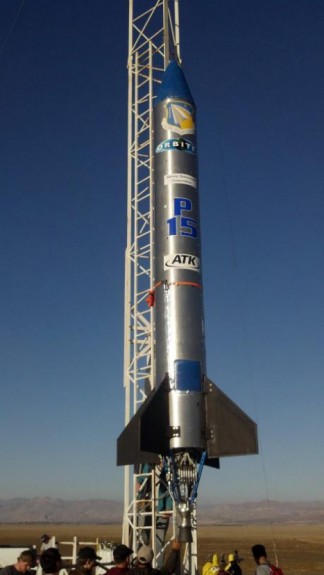This New Rocket Engine Has a Fuel Tornado Inside
A new fuel-mixing technology could drive down the cost of spaceflight

A rocket using the new vortex fuel technology carried out a test flight in October. Photo: Orbitec
Since the early days of modern rocketry, with the pioneering work of Robert H. Goddard in the mid-1920s, most rockets have relied on a liquid-fuel engine to hurl them to the sky. NASA:
While working on solid-propellant rockets, Goddard became convinced that a rocket could be propelled better by liquid fuel. No one had ever built a successful liquid-propellant rocket before. It was a much more difficult task than building solid-propellant rockets. Fuel and oxygen tanks, turbines, and combustion chambers would be needed. In spite of the difficulties, Goddard achieved the first successful flight with a liquid- propellant rocket on March 16, 1926.
In a liquid-fuel engine, says the BBC, high-pressure fuel and an oxidizer mix together in the combustion chamber. The mix burns hot and produces exhaust that is then forced through a nozzle as the base of the ship, sending it into the sky. But the immense thrust of a liquid-fuel rocket comes with its own downside, of course: the engine gets hot, “upwards of 3,000°C (5,400°F).”
For the past few years, however, scientists have been working on a new technology to overcome the engine heat balancing act. Rather than letting the oxidizer and fuel flow into the combustion chamber normally, a new type of engine designed by Orbital Technologies Corporation pumps the oxidizer into the engine at a particular angle, a tweak that sets up a vortex of swirling fuel within the engine.
“y placing the oxidiser nozzles at the base of the combustion chamber and aiming them tangentially to the inner surface of its curving walls,” says the BBC, the rocket scientists’ tweak “produces an outer vortex of cool gases that spiral up the walls forming a protective, cooling barrier.”
When this meets the top of the chamber it is mixed with rocket fuel and forced inward and down, forming a second, inner, descending vortex in the centre of the chamber that is concentrated like a tornado. The escaping downward stream of hot, high-pressure gases are then forced through the nozzle at the back of the chamber, producing thrust.
The double-vortex within the engine keeps the hot mix away from the combustion chamber’s walls, meaning that they won’t be afflicted by the same searing temperatures that affect normal liquid-fueled rockets.
As well as keeping the exterior of the system cool, the vortex also works to burn the rocket fuel more efficiently by promoting more complete mixing of the fuel and air in a confined area. In addition, the longer path of the spinning vortices give the fuel more opportunity to burn, meaning the chamber height can be reduced, making for a significant weight savings – and therefore cost – savings.
More from Smithsonian.com:
/https://tf-cmsv2-smithsonianmag-media.s3.amazonaws.com/accounts/headshot/smartnews-colin-schultz-240.jpg)
/https://tf-cmsv2-smithsonianmag-media.s3.amazonaws.com/accounts/headshot/smartnews-colin-schultz-240.jpg)